I'd hoped to be able to post the news of who won leg 2 of the Volvo Ocean race, but there are still 25 miles to go on a leg that has taken longer than expected. But unless there is a Mike Golding "my keels just fallen off" sort of moment, it looks like Mike Sanderson and crew on ABN AMRO ONE, nick named Black Betty, will be picking up the full 14 points.
So congratulations to them and see you in a week, as Captain JP is off skiing.
Saturday, January 21, 2006
Friday, January 20, 2006
Its not over till its over

Earlier in leg 2 of the Volvo Ocean Race, Mike Sanderson's Black Betty was over 350 miles ahead of the rest of the fleet, only to see their lead evaporate at the windless centre of a high.
With under a hundred miles to the finish line in Port Phillip Bay he must be gnawing his fingernails to the bone wondering if the juniors on ABN AMRO TWO are to catch him again.
Now what matters is not the grib files and routing software, but knowledge and experience of sea breaze and tidal flows.
And who wants that first beer the most.
All in all, a bit like this year's Fastnet then!
Picture from Virtual Spectator
Wednesday, January 18, 2006
Four keels and a dismasting
Yet another casualty on the second leg of the Volvo Ocean Race from Cape Town to Melbourne across the southern oceans. On this leg there has already been not one, not two, not three, but four of the seven boats suffering keel problem. Now Brazil has broken its mast in three places and is limping towards Australia under jury rig. With over 2,000 miles to go and the clock ticking till the next in-port race on the 4th February it looks they have no choice but to retire and head to Albany after picking up the Eclipse Island points.
This will more ammunition to the critics of the new Volvo 70. But no one will be able to say it's not been an eventful race, full of drama.
On the one hand the design has shown that monohulls can compete with multis with the 24 hour speed record raised to an amazing 563 miles. On the other a new design where only two boats have not (yet) suffered serious keel or mast failure is at the very least on a steep learning curve.
Meanwhile Pirates having tested their reparis by trying out most sail angles have settled down chasing movistar and the ABN twins towards Melbourne. With under 600 miles between Black Betty and Melbourne it seems unfair that there's a head wind between them and those longed for cold ones. As the forecast below in the figure shows, they can expect 20 knots from the north east. And they are heading, yes thats right, north east.
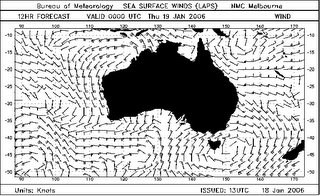
Pictures from Australian Bureau of Meteorology
This will more ammunition to the critics of the new Volvo 70. But no one will be able to say it's not been an eventful race, full of drama.
On the one hand the design has shown that monohulls can compete with multis with the 24 hour speed record raised to an amazing 563 miles. On the other a new design where only two boats have not (yet) suffered serious keel or mast failure is at the very least on a steep learning curve.
Meanwhile Pirates having tested their reparis by trying out most sail angles have settled down chasing movistar and the ABN twins towards Melbourne. With under 600 miles between Black Betty and Melbourne it seems unfair that there's a head wind between them and those longed for cold ones. As the forecast below in the figure shows, they can expect 20 knots from the north east. And they are heading, yes thats right, north east.

Pictures from Australian Bureau of Meteorology
Tuesday, January 17, 2006
Counting down the tacks
 With ABN AMRO ONE less than a thousand miles from the finish line of Leg 2 of the Volvo Ocean Race, can they count down the tacks as they count down the miles?
With ABN AMRO ONE less than a thousand miles from the finish line of Leg 2 of the Volvo Ocean Race, can they count down the tacks as they count down the miles?As one heads east in the picture above, the wind becomes increasingly southerly - so might even a single tack finish be possible?
Alas over the next few days the wind is backing increasingly northerly as can be seen in the figure below of Thursday's forecast. So there's more work to do before the sweet sound of the finishing gun.
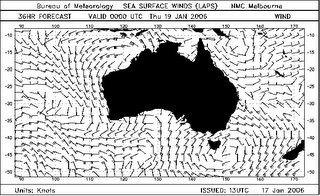
Pictures from Virtual Spectator and Australian Bureau of Meteorology
Pirates ahoy!
 The Pirates have launched back to sea but are they ready for battle? Their course has been erratic over the last few hours, tacking from side to side as a true drunken sailor. Is their keel really back to 100%? They have the time in hand with 500 miles over ING - so could another land raid be in order?
The Pirates have launched back to sea but are they ready for battle? Their course has been erratic over the last few hours, tacking from side to side as a true drunken sailor. Is their keel really back to 100%? They have the time in hand with 500 miles over ING - so could another land raid be in order?Picture from Virtual Spectator
Sunday, January 15, 2006
Its not over till the fat lady sings
 Just as the Moose and the grown ups on Black Betty seemed to have Leg 2 all wrapped up the boys on ABN AMRO TWO gave them a shock by nosing in front.
Just as the Moose and the grown ups on Black Betty seemed to have Leg 2 all wrapped up the boys on ABN AMRO TWO gave them a shock by nosing in front.It didn't last - as of this posting ABN AMRO ONE is yet again at the top of the leader's board. But this is feeling like a mid-leg re-start for the three leading boats currently compressed into under 30 miles.
Mike and co have slightly stronger wind but also slightly less advantageous wind angle for the final 400 miles to Eclipse Island. Then, as the figure below shows, a beat to windward to Melbourne.
 By now thoughts will have turned to showers, clean clothes, beers, proper food, more beers, and beds. But with the competition so intense none of them can relax. And an ever nagging worry must be - will any other boats suffer major damage?
By now thoughts will have turned to showers, clean clothes, beers, proper food, more beers, and beds. But with the competition so intense none of them can relax. And an ever nagging worry must be - will any other boats suffer major damage?For in the last few days both movistar and Pirates have had their own keel problems which the ABN duo have so noticably avoided. The Volvo 70's relability and more importantly suitability, is a topic that has stirred much controversy - so more on this later.
Pictures from Virtual Spectator and NOAA
Saturday, January 14, 2006
Slowing down, stacking up
 As the Volvo boats approach Australia they are slowing, compressing what remains of the fleet close together, with Two now under a hundred miles from One.
As the Volvo boats approach Australia they are slowing, compressing what remains of the fleet close together, with Two now under a hundred miles from One.For Mike Sanderson is heading straight into the centre of a high and the reported wind speed at ABN AMRO ONE is a mere 5 knots.
But he has little choice. There seems no way round the band of slow wind as can be seen in the figure below so he is forced on the direct route however frustrating that will be (for reference his approximate location is 40S 110E).

So there's hope for the chasing pack. But after they round Eclipse Island it looks like they'll be back in bumpy upwind sailing. Lets hope nothing more breaks.
And talking of tough upwind sailing, its good to hear that Dee Caffari has come through the gale in the south pacific off Cape Horn and is now sailing west under blue skies with winds in the 20 - 30 knot range.
Pictures from Virtual Spectator and NOAA
Wednesday, January 11, 2006
Two fast
Congratulations to the lads on ABN AMRO TWO who today broke the 24 hour speed record again and again to finally reach an amazing 560 miles!
It proves what the amazing boats of the Volvo 70s are capable of achieving. All the bells and whistles from carbon hulls to canting keels are stretching what a racing monohull can do. But there has been criticism of the new designs as well.
One frequently heard complaint is that they are too easy to break. But new designs are oft tested to destruction on their first real trials. And there are no end of Open 60s that have broken in the anvil of the Bay of Biscay. Mike Sanderson for one has been emailing his support for Black Betty and her cousins.
A more serious complaint is the complexity means high cost which means small fleets. Which raises the question, what makes an exciting Volvo? Is it the latest technology and record breaking speeds or is following a pack of competitors?
What do you think?
It proves what the amazing boats of the Volvo 70s are capable of achieving. All the bells and whistles from carbon hulls to canting keels are stretching what a racing monohull can do. But there has been criticism of the new designs as well.
One frequently heard complaint is that they are too easy to break. But new designs are oft tested to destruction on their first real trials. And there are no end of Open 60s that have broken in the anvil of the Bay of Biscay. Mike Sanderson for one has been emailing his support for Black Betty and her cousins.
A more serious complaint is the complexity means high cost which means small fleets. Which raises the question, what makes an exciting Volvo? Is it the latest technology and record breaking speeds or is following a pack of competitors?
What do you think?
Tuesday, January 10, 2006
More points for ONE
First blood to the Moose, as ABN AMRO ONE earns 3.5 points for leading at the first mark. It's been a good leg so far for Black Betty, as Mike and the team have shown they have what it takes to win this leg and, as many must be whispering, the Volvo.
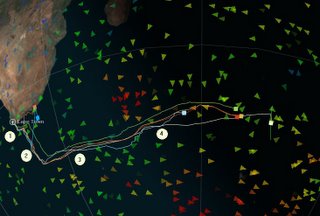 The figure above shows four key stages where ABN AMRO ONE 's actions have helped land those valuable points:
The figure above shows four key stages where ABN AMRO ONE 's actions have helped land those valuable points:
1) Getting through the first hours without major breakages (unlike Ericsson)
2) Heading straight south for the stonger winds (unlike movistar)
3) Showing its edge in boat speed to get her nose ahead (of Pirates)
4) And the lucky bonus of the front to jump 300 miles ahead (of everyone)
Now past the gates ABN AMBRO ONE is unconstrained in latitude and has turned sharply south through a remarkable 90 degrees. It's a bit surprising - they can surely gybe over a smaller angle. As there's no geometric reason for heading south it can only be the hunt for wind. And as can be seen from the NOAA figure below, there isn't much wind at 40S but much more at 45S.
 Most importantly of all, by adding a dog leg south they can cover the pack behind, now led by the youngsters on ABN AMRO TWO.
Most importantly of all, by adding a dog leg south they can cover the pack behind, now led by the youngsters on ABN AMRO TWO.
So while the stats show the pack catching up dramatically - already a hundred miles have disappeared into sea spray - there's still only one boat dominating this leg.
Figures from Virtual Spectator and NOAA
 The figure above shows four key stages where ABN AMRO ONE 's actions have helped land those valuable points:
The figure above shows four key stages where ABN AMRO ONE 's actions have helped land those valuable points:1) Getting through the first hours without major breakages (unlike Ericsson)
2) Heading straight south for the stonger winds (unlike movistar)
3) Showing its edge in boat speed to get her nose ahead (of Pirates)
4) And the lucky bonus of the front to jump 300 miles ahead (of everyone)
Now past the gates ABN AMBRO ONE is unconstrained in latitude and has turned sharply south through a remarkable 90 degrees. It's a bit surprising - they can surely gybe over a smaller angle. As there's no geometric reason for heading south it can only be the hunt for wind. And as can be seen from the NOAA figure below, there isn't much wind at 40S but much more at 45S.
 Most importantly of all, by adding a dog leg south they can cover the pack behind, now led by the youngsters on ABN AMRO TWO.
Most importantly of all, by adding a dog leg south they can cover the pack behind, now led by the youngsters on ABN AMRO TWO.So while the stats show the pack catching up dramatically - already a hundred miles have disappeared into sea spray - there's still only one boat dominating this leg.
Figures from Virtual Spectator and NOAA
Monday, January 09, 2006
Gates and Great Circles
One of the simplest rules of thumb for yacht navigators on ocean races is that the shortest distance is often the quickest. The other is of course to follow the winds. For leg 2 of the Volvo Ocean Race, both thumbs would be pricking with the same message - head down into the furious fifties.
The figure below shows the direct great circle route from Cape Town to Melbourne - and its clear to sail the shortest distance you have to get down to about 58S.
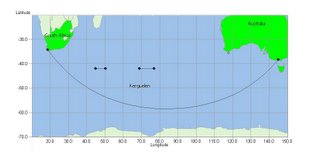 Then of course theres getting the strongest wind, and wind in the right direction. Again as the NOAA forecast below shows, a good latitude is below 50S.
Then of course theres getting the strongest wind, and wind in the right direction. Again as the NOAA forecast below shows, a good latitude is below 50S.
 But the fleet has stayed up at around 41 - 43S, where as can be seen in the graphic above the weather is the sort of mix of variability and complexity that gives navigators nightmares of sitting in a wind hole while the whole crew insists they don't blame him really.
But the fleet has stayed up at around 41 - 43S, where as can be seen in the graphic above the weather is the sort of mix of variability and complexity that gives navigators nightmares of sitting in a wind hole while the whole crew insists they don't blame him really.
The answer is the existence of a set of ice gates and way points as shown in the top figure. The two ice gates are both at 42S and the fleet must also round Eclipse Island forcing them much further north than their routing programs would otherwise have liked. But with ice spotted up at 47S thats probably just as well.
Meanwhile Mike and the boys on Black Betty have a stomping 326 mile lead over the Pirates who are working hard to fight off the ABN juniors just 7 miles astern.
The figure below shows the direct great circle route from Cape Town to Melbourne - and its clear to sail the shortest distance you have to get down to about 58S.
 Then of course theres getting the strongest wind, and wind in the right direction. Again as the NOAA forecast below shows, a good latitude is below 50S.
Then of course theres getting the strongest wind, and wind in the right direction. Again as the NOAA forecast below shows, a good latitude is below 50S. But the fleet has stayed up at around 41 - 43S, where as can be seen in the graphic above the weather is the sort of mix of variability and complexity that gives navigators nightmares of sitting in a wind hole while the whole crew insists they don't blame him really.
But the fleet has stayed up at around 41 - 43S, where as can be seen in the graphic above the weather is the sort of mix of variability and complexity that gives navigators nightmares of sitting in a wind hole while the whole crew insists they don't blame him really.The answer is the existence of a set of ice gates and way points as shown in the top figure. The two ice gates are both at 42S and the fleet must also round Eclipse Island forcing them much further north than their routing programs would otherwise have liked. But with ice spotted up at 47S thats probably just as well.
Meanwhile Mike and the boys on Black Betty have a stomping 326 mile lead over the Pirates who are working hard to fight off the ABN juniors just 7 miles astern.
Sunday, January 08, 2006
How far south?
 Overnight ABN AMRO ONE has extended her lead over Pirates from 35 to 115 miles. Given that the gap between the leading two has changed only slowly for the previous day or so its worth asking how Mike, Betty and the boys pulled out so clearly.
Overnight ABN AMRO ONE has extended her lead over Pirates from 35 to 115 miles. Given that the gap between the leading two has changed only slowly for the previous day or so its worth asking how Mike, Betty and the boys pulled out so clearly.To find the answer we must understand what the weather has been down there, which means looking further afield than the otherwise excellent Virtual Spectator.
As you can see in the picture above VS shows the wind direction and strength using animated coloured arrows at the time of the latest data point. VS can also show isobar contour - but alas the code behind that feature isn't compatible with my laptop, and so for me is unusable. The other problem is its only a snap-shot - it doesn't show historical data or forecast what is to come. So we must go searching the web for those that do.
This isn't always easy. Most weather forecasts cover areas of land - and populated land at that. It is only a small minority that cares what the wind strengths are in the depths of the southern oceans. However a few can be unearthed, and an answer to our question can be found.
The follow graphic comes from this site.
 The fleet is currently between 41S and 43S and 46E to 52E. In this region the contours are spread out, showing weaker winds. And that is what the on-board telemetry shows: ING at the back has just 10 knots of wind.
The fleet is currently between 41S and 43S and 46E to 52E. In this region the contours are spread out, showing weaker winds. And that is what the on-board telemetry shows: ING at the back has just 10 knots of wind.However AMN AMRO ONE has its nose just ahead of both the fleet and the front where the contours are just a little more packed and so is sailing in 21 knots of wind. Yet again another example of "to the winners the spoils".
And what do we see coming up? From this site we get the 24 hour forecast.

We can see a finger of weak wind around 45S. Any boat that ventured south of it into the furious fifties would indeed gain much stronger wind - but at the significant risk of iceburgs. So the objective for the next day or so must be to try stay in that band of green where its a rather pleasant 30 knots. And avoid those wind holes.
Pictures from the web sites mentioned and Virtual Spectator
Friday, January 06, 2006
Foot on the floor
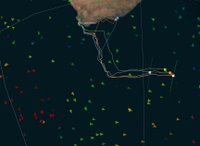 The Volvo fleet - or what remains of it - is now powering its way towards Melbourne. Well, maybe not as powered as many would like, for the some the sun is out, the temperature warm and the wind for the leader ABN AMRO ONE a rather mild 15 knots.
The Volvo fleet - or what remains of it - is now powering its way towards Melbourne. Well, maybe not as powered as many would like, for the some the sun is out, the temperature warm and the wind for the leader ABN AMRO ONE a rather mild 15 knots.Behind them stalks a 50 knot low, as can be seen in the picture above, and its noticable that the back of the fleet has significantly stronger wind than the front.
But the depression is taking its time in catching up, so the fleet is enjoying themselves - apart from Adam Hawkins on ING Real Estate Brunel who had to dive into the freezing water to free fragments of a spinnaker wraped around the keel.
There was an interesting article at the Volvo site about how the new designs need a new approach from skippers. Less foot on the floor - more management of the boat. But is that really a change? After all a key skill of all skippers from day sailors to round the world professionals is seamanship - reef the main and reduce the size of the jib when the wind rises.
It also calls the foot on the floor approach macho, which can't be right. As the breakages of the last few days have shown, upwind is tougher than downwind. The sort of sailing that needs steel not carbon fibre. The sort of sailing currently being "enjoyed" by, er, Dee Caffari.
Pictures from Virtual Spectator
Thursday, January 05, 2006
Ice and storms
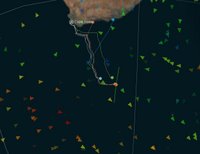 All aboard!
All aboard!As the pack led by ABN AMRO ONE heads south it has already picked up the westerly conveyor belt that will accelerate them towards Melbourne.
The effect has been clearly seen in the leader's board, where movistar has dropped from first to fourth, its westerly route giving only a short term advantage.
And Moose (and his crew Skunk, Numbsy, Big Tone, Bob, Sid, Irish et al) must be pretty pleased - not just leaders but also well positioned to pick up the low building to their south-west, with strengthing winds just what their boat designers wanted.
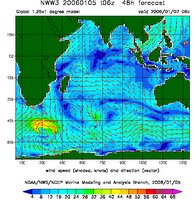
Its a long way to Oz-land, and its already been shown how these boats can break. The figure to the right shows the wind forcecast by NOAA for the 7th, where the low builds into a storm with up to 50 knot of wind.
Black Betty will have to handle storms and ice to repeat the triumphs of the last leg. And icebergs have been spotted at 49S. The boats might be still up at 43S but no one wants to crash into a growler when charging through the night at 30 knots.
But the charge to Melbourne has begun!
Pictures from Virtual Spectator and NOAA
Dee rounds the Horn
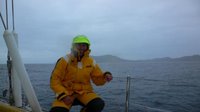 Another milestone for Dee Caffari as she rounded Cape Horn. Heading west like the buccaneers of old searching for adventure in the great wide Pacific, she also managed something she had feared she would never do - actually see the infamous island itself. For last rounding during the last Global Challenge she might have had the company of crew but alas missed seeing Cape Horn as they rounded it in the wee hours of the morning.
Another milestone for Dee Caffari as she rounded Cape Horn. Heading west like the buccaneers of old searching for adventure in the great wide Pacific, she also managed something she had feared she would never do - actually see the infamous island itself. For last rounding during the last Global Challenge she might have had the company of crew but alas missed seeing Cape Horn as they rounded it in the wee hours of the morning.Thankfully she won't have to do a third circumnavigation to tick that from the list of memorable sailor's experiences, as she can now tell us all about the colour (green) the smell (seaweed) and the sounds (of Cape Horn Radio).
She even got in a photo shoot by making the day of a cruise ship called the Henseatic and was fortunate to find a gap in the storms with wind strengths of only 5 knots. Hopefully the warm glow of todays excitment will be keep her going during the long bash to windward across the southern oceans.
Picture from Aviva Challenge
Wednesday, January 04, 2006
Oops, they did it again
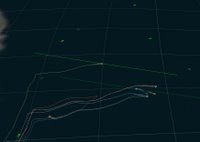 The start of the second offshore leg is looking a lot like the start of the first with two boats already turning back to Cape Town with structural problems. In the early hours of this morning Ericsson reported hearing a great bang which after investigations proved to be a broken keel ram piston rod. Then just after sunrise Brazil reported a crack in its hull near the cockpit, and turned its course to the north.
The start of the second offshore leg is looking a lot like the start of the first with two boats already turning back to Cape Town with structural problems. In the early hours of this morning Ericsson reported hearing a great bang which after investigations proved to be a broken keel ram piston rod. Then just after sunrise Brazil reported a crack in its hull near the cockpit, and turned its course to the north.The fleet had been battling upwind in strong winds that contrasted with the light winds of the start. These Volvo boats are engineered using material such as carbon fibre to be as light weight as possible - good for speed but it makes sailing close hauled in heavy seas punishing for crew and boat alike.
But at least these breakages happened close to land. In a few days time the boats will be a thousand miles from any land and escape from the ceaseless pounding of wind and wave.
Tuesday, January 03, 2006
Around as well
The Volvo is not the only global race ploughing through across the seas this new year. As summer comes to the southern oceans the racing boats take their chances.
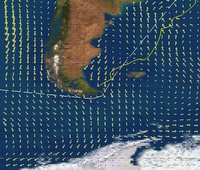 Battling her way round Cape Horn is Dee Caffari, attempting to be the first solo woman to sail westward around the world. Having sorted her broken auto-pilot, she is now faced with the less deadly problem of having no fresh bread till her oven gas pipe is fixed.
Battling her way round Cape Horn is Dee Caffari, attempting to be the first solo woman to sail westward around the world. Having sorted her broken auto-pilot, she is now faced with the less deadly problem of having no fresh bread till her oven gas pipe is fixed.
Mean while the Clipper fleet is heading out from Fremantle on its leg up to Qingdao in China via Singapore. Some of the crew of Liverpool had the dubious pleasure of the St Malo run this year with JP, and this leg sounded a lot of fun, so best wishes to them and hope they get better weather than we had!
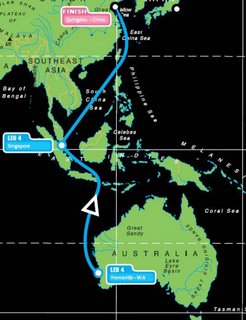
 Battling her way round Cape Horn is Dee Caffari, attempting to be the first solo woman to sail westward around the world. Having sorted her broken auto-pilot, she is now faced with the less deadly problem of having no fresh bread till her oven gas pipe is fixed.
Battling her way round Cape Horn is Dee Caffari, attempting to be the first solo woman to sail westward around the world. Having sorted her broken auto-pilot, she is now faced with the less deadly problem of having no fresh bread till her oven gas pipe is fixed.Mean while the Clipper fleet is heading out from Fremantle on its leg up to Qingdao in China via Singapore. Some of the crew of Liverpool had the dubious pleasure of the St Malo run this year with JP, and this leg sounded a lot of fun, so best wishes to them and hope they get better weather than we had!

Monday, January 02, 2006
Where's the wind?
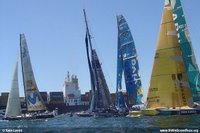 Forget the forty knots of wind, the second offshore leg of the Volvo Ocean race has seen the boats drifting in light winds with several collisions and penalty turns. Playing bumper boats at the mark, ABN AMBRO ONE bashed into Ericsson, bending one of her stanchions then Ericsson had an incident with Brazil.
Forget the forty knots of wind, the second offshore leg of the Volvo Ocean race has seen the boats drifting in light winds with several collisions and penalty turns. Playing bumper boats at the mark, ABN AMBRO ONE bashed into Ericsson, bending one of her stanchions then Ericsson had an incident with Brazil.Net result - protests and a couple of 360s and 720s.
And there are over 6,000 miles of racing to go.
Catching Moose
Today the boats of the Volvo Ocean race left the warmth of Cape Town heading down into the cold of the great Southern Ocean. It's a much anticipated leg, when the new Volvo 70s will be tested in waters where the wind and waves circle the planet for ever.
With two scoring way points there are 14 points up for grabs, points that change the leader border, currently looking like this:
Mike Sanderson, skipper of ABN AMRO ONE and commonly known as Moose , may have a fast boat and a good position but still there are no certainties apart from the old saying that to finish first you first have to finish.
To win at this level where all boats are crewed by skilled sailors what matters is:
1) For nothing critical to break
2) For the navigator to read the weather fronts right
3) For the boat to be fast on the wind angle that dominates the leg
Its going to be an interesting race to watch - lets hope its also a safe leg.
With two scoring way points there are 14 points up for grabs, points that change the leader border, currently looking like this:
| 1 | ABN AMRO ONE | 15 |
| 2 | Brasil 1 | 12.5 |
| 3 | ABN AMRO TWO | 12 |
| 4 | Ericsson Racing Team | 11.5 |
| 5 | movistar | 6 |
| 6= | ING Real Estate Brunel | 5 |
| 6= | Pirates of the | 5 |
Mike Sanderson, skipper of ABN AMRO ONE and commonly known as Moose , may have a fast boat and a good position but still there are no certainties apart from the old saying that to finish first you first have to finish.
To win at this level where all boats are crewed by skilled sailors what matters is:
1) For nothing critical to break
2) For the navigator to read the weather fronts right
3) For the boat to be fast on the wind angle that dominates the leg
Its going to be an interesting race to watch - lets hope its also a safe leg.
Subscribe to:
Comments (Atom)